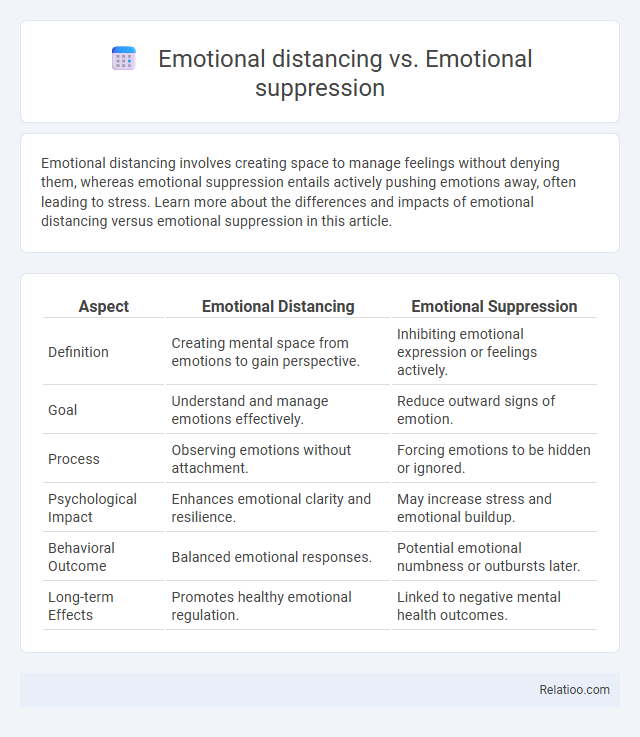Emotional distancing involves creating space to manage feelings without denying them, whereas emotional suppression entails actively pushing emotions away, often leading to stress. Learn more about the differences and impacts of emotional distancing versus emotional suppression in this article.
Table of Comparison
| Aspect | Emotional Distancing | Emotional Suppression |
|---|---|---|
| Definition | Creating mental space from emotions to gain perspective. | Inhibiting emotional expression or feelings actively. |
| Goal | Understand and manage emotions effectively. | Reduce outward signs of emotion. |
| Process | Observing emotions without attachment. | Forcing emotions to be hidden or ignored. |
| Psychological Impact | Enhances emotional clarity and resilience. | May increase stress and emotional buildup. |
| Behavioral Outcome | Balanced emotional responses. | Potential emotional numbness or outbursts later. |
| Long-term Effects | Promotes healthy emotional regulation. | Linked to negative mental health outcomes. |
Understanding Emotional Distancing
Emotional distancing involves creating a psychological space between oneself and emotions to gain perspective, differing from emotional suppression, which entails consciously pushing feelings away to avoid experiencing them. Understanding emotional distancing helps individuals regulate intense emotions without ignoring or denying them, promoting healthier mental processing. This technique often supports emotional resilience by allowing a balanced awareness rather than emotional avoidance.
Defining Emotional Suppression
Emotional suppression refers to the conscious effort to inhibit or hide emotional responses, often leading to increased physiological stress and prolonged emotional distress. Unlike emotional distancing, which involves creating psychological space to detach temporarily from emotions for better regulation, suppression actively blocks the expression of feelings. Understanding emotional suppression is crucial for recognizing its impact on mental health, as persistent suppression can contribute to anxiety, depression, and impaired emotional processing.
Psychological Mechanisms Behind Both Strategies
Emotional distancing involves creating a psychological space between you and your feelings to reduce emotional intensity, while emotional suppression requires consciously inhibiting the expression of emotions without necessarily diminishing their internal experience. The psychological mechanisms behind emotional distancing engage cognitive reappraisal, allowing your brain to reinterpret emotional stimuli, whereas suppression triggers increased cognitive load and physiological stress by forcing hidden emotional responses. Understanding these mechanisms helps you manage emotions in a healthier way by favoring cognitive strategies over avoidance or repression.
Key Differences Between Emotional Distancing and Suppression
Emotional distancing involves creating a healthy mental space to observe feelings without becoming overwhelmed, helping you regulate reactions effectively. Emotional suppression, however, is the conscious effort to push down or ignore emotions, which can lead to increased stress and emotional buildup over time. Understanding these key differences allows your emotional well-being to improve by promoting awareness rather than avoidance of feelings.
Common Triggers for Emotional Distancing
Common triggers for emotional distancing include fear of vulnerability, past trauma, and feelings of rejection or abandonment, which push You to create psychological space to protect Yourself from further pain. Emotional suppression often arises from societal expectations or personal beliefs that expressing emotions is a sign of weakness, causing the deliberate inhibition of feelings. In contrast, emotional distancing is a coping mechanism triggered by overwhelming stress or conflict, prompting disconnection from emotions to maintain control and stability.
Short- and Long-Term Effects of Emotional Suppression
Emotional suppression involves consciously inhibiting emotional expressions, leading to short-term relief but increased physiological stress and decreased social support over time. In contrast, emotional distancing, a coping strategy of maintaining psychological space from emotions, can promote resilience and reduce immediate distress without the adverse health outcomes linked to suppression. Long-term emotional suppression is associated with negative consequences such as impaired emotional regulation, heightened anxiety, and reduced overall well-being.
Emotional Distancing in Relationships
Emotional distancing in relationships involves creating a psychological space to protect oneself from intense feelings or conflict, promoting healthier boundaries and self-awareness compared to emotional suppression, which entails unconsciously pushing emotions away, often leading to internal stress or unresolved issues. Unlike emotional suppression, emotional distancing allows individuals to regulate their emotions without negating their experiences, fostering communication clarity and reducing relational tension. Understanding emotional distancing helps partners maintain emotional balance while navigating challenges, ultimately supporting relationship resilience and mutual respect.
Mental Health Consequences of Emotional Suppression
Emotional suppression involves consciously avoiding or inhibiting feelings, leading to increased stress and a higher risk of anxiety and depression due to unresolved emotional tension. Emotional distancing refers to creating psychological space from feelings or relationships, which can protect mental health in the short term but may cause isolation if overused. Your mental health suffers most from emotional suppression, as it disrupts natural emotional processing and impairs well-being over time.
Healthy Alternatives to Emotional Distancing and Suppression
Healthy alternatives to emotional distancing and suppression include practicing emotional awareness and mindfulness to acknowledge feelings without judgment, fostering open communication to express emotions constructively, and engaging in therapeutic techniques like cognitive-behavioral therapy (CBT) to reframe negative thought patterns. Building strong social connections and developing adaptive coping skills such as journaling or creative outlets can also promote emotional resilience. These strategies enhance emotional regulation without disconnecting from or invalidating one's internal experiences.
Choosing Adaptive Emotional Regulation Strategies
Choosing adaptive emotional regulation strategies involves recognizing the differences between emotional distancing, emotional suppression, and emotional avoidance. Emotional distancing allows you to create a healthy mental space from intense feelings without negating them, promoting resilience and clarity. Emotional suppression often leads to increased stress and unresolved emotions, while emotional avoidance can hinder emotional growth and problem-solving, making emotional distancing a more effective approach for long-term well-being.

Infographic: Emotional distancing vs Emotional suppression
 relatioo.com
relatioo.com